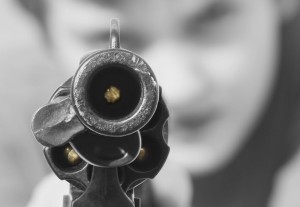By John Ramsey Miller
At some point during our careers we get something wrong and editors and proofreaders miss it, but some reader somewhere will always find it and might just rub your nose in it. And there it is forever––the screwing of the pooch––immortalized, bound between covers. Some readers are so anal they’ll go through a novel with a fine tooth comb to find every misused semi-colon, every missing or extra comma throughout a novel so they can perform a “superior” jig. But for some readers there is no bigger turnoff than stumbling over an inaccuracy on a subject or a location that they know. Turning off readers is the last thing we authors can afford to do.
It has been my experience that we authors can’t depend on our editors, or copy editors, to catch inaccuracies because those professionals may assume we know more about a subject than they do, and the author should indeed be in that position.
I remember a copy editor on INSIDE OUT made a note on the manuscript informing me that New Orleans didn’t have an Italian “mafia” like the families in New York and Chicago. Sam Manelli, (my fictional Don), was therefore not plausible. I sent an e-mail to the editor explaining to her that Carlos Marcello’s organized crime organization was the single largest industry in Louisiana in the 70s and 80s, generating an estimated two billion dollars a year. Marcello’s crime organization was larger, more successful, and just as violent as any other Mafia organization. (http://www.crimelibrary.com/gangsters_outlaws/family_epics/marcello/1.html)
I’ve always been interested in guns (particularly handguns) and I have owned dozens of them and I’ve been shooting most of my life. But when I write about guns I still double-check my technical information with people who are more knowledgeable than I am with a specific gun, or other ordnance. I also own several volumes of Shooter’s Bible and Gun Digest––available in any bookstore––which offers technical information on thousands of firearms. These reference books contain critical details on thousands of guns and will tell you how many bullets (or shells) a gun holds, how to spell the name, what caliber(s) a gun is made to handle, its weight, size, barrel lengths, and other tidbits you might leave out but that should know. You can go to a gun store and ask the clerk to show you the guns you are going to write about. And shoot one. Some gun ranges rent handguns, so you can become familiar with the experience of firing a weapon.
And, outside of Hollywood (the Capital City of inaccuracy), those who are shot with guns are not propelled backwards. Due to the way muscles and tendons operate, most humans will collapse forward (even collapsing toward the weapon). Even victims of a machine-gun burst or a 12 gauge double-ought blast will not take flight because bullets and even buckshot do not transfer the energy necessary to move the weight of a human being. Don’t just take my word for it, those two goofy debunkers on TV’s Mythbusters gleefully shot a hog carcass with handguns, rifles and shotguns, and the hung-up carcass didn’t even swing from the impact. Okay, the point is, people out there know their stuff, and if a gun person reads that a revolver has a safety (or a clip) you will loose that reader forever, and he will tell his gun buddies and they will laugh at you and never again open one of your books.
When I write about professionals, I interview them. I’ve talked extensively with US Marshals, Homeland Security personnel, TSA officials, FBI agents, agents with the DEA, CIA operatives, bounty hunters, homicide detectives from several cities, beat cops, and deputy sheriffs. I will interview attorneys, coroners, physicians, judges, herpetologists, forensic experts, and any other professionals who can answer my questions on any related subject. The plain truth is: experts are delighted to help you get it right. Ninety-nine percent of the time knowledgeable individuals will be delighted to tell you more than you need to know about their area of expertise.
For my first Thriller, THE LAST FAMILY, I was imagining a character who was going to kill a child using the curare-like drug, Succinocholine, a fast-acting paralytic commonly used by anesthesiologists. (I later changed the victim to a grown woman and threw the boy off a cliff). Given in large amounts the drug stops the heart muscles cold. I called the Mississippi State Medical Examiner out of the blue, and merely said, “I’m John Miller, and I’m writing a novel. I need to know how much Succinocholine it would take to kill a 9-year-old child.” After about three beats, the doctor replied, “How much does the child weigh?”
Before we hung up, I told him I’d never witnessed an autopsy, and he told me to drive down and he’d treat me to one. Several days later, I was standing beside a stainless table in Brandon, Mississippi, watching the good doctor ply his trade. As a result I can write a believable autopsy scene because I know what the room and the action looks and sounds like, and even why the good doctor smoked cigars while deconstructing corpses.
You can set a story in a fictional place, based on a real one or plucked strictly from your imagination. If you use a real place as a setting, go there and walk it, or change the location to one you can walk. If you write about the French Quarter in New Orleans, you should know which direction the one-way streets run and what the buildings look like on those streets. Being there allows you to gather impressions. Learn what a place smells like, how the people on the street look, and the phrasing and cadence of their speech. Gather names of your local characters from people you meet, from gravestones or local phone books. It’s about the details. It is as important to write where you know, as well as what you know. Your readers––those who know––will notice the difference, and those who don’t will still appreciate your descriptions.
When I set UPSIDE DOWN in New Orleans I walked side streets and used locations around the French Quarter that tourists never see, as well as some they might. When I had a character running for her life, I walked her route, and experienced for myself what she would be seeing, hearing and smelling as she fled from professional killers. Even though I lived in New Orleans for nine years, I made a trip back to the Crescent City to see what things in the area had changed radically during my absence.
I had crucial scenes in UPSIDE DOWN that take place on the Canal Street Ferry, so I went on the Thomas Jefferson, asked for the engineer and he gave me a tour of the vessel. I asked him how my character might go about taking over the boat, and he told me. I walked the vessel with the engineer and took a lot of pictures for reference, timed the crossing, asked the crew questions and I made notes that included my impressions and the names of any items I might want to write into my story.
When I sat down to write those chapters I was able to choreograph action knowing which doors led where, how long the trip across the River took, and exactly where everybody who worked or rode on the boat might be during a run across the river. I knew how many people worked on the ferry and what job each of the crew was responsible for. I studied the passengers, and watched how the cars came on, how they were parked, and how they exited the vessel. When I wrote the action months later, I could close my eyes and be on the vessel. I could smell the river and the engine exhaust, and hear the engine, the horns of other vessels, the sound of the Thomas Jefferson’s bow pushing through the still surface, and the voices of the passengers heading home after a long day.
You can learn a great deal about a place over the internet, and by talking to people on the phone, but the important impressions you certainly can’t get that way, and the little things allow the reader to more fully experience a late-night ride across the Mississippi River. I changed some minor things on my ferry, but I was accurate where it counted. By the time I finished those chapters, I was sure that only the man who designed the vessel and the people who work on her would spot my changes, but I was confident that very few others would.
Poetic license won’t cover blatant ignorance on a subject or a real setting you are writing into your book. Research involves an investment in an author’s time, energy and (often as not) some expense, but I believe that my primary job is to entertain my readers and make sure they get the best story I can write. As an author, I believe I owe my readers as much realism and texture as I can write into a fictional story.





